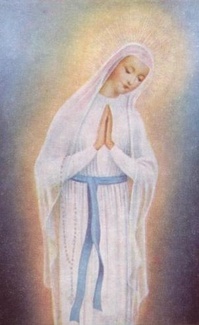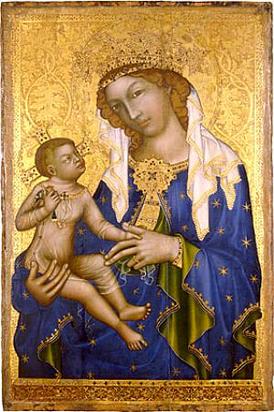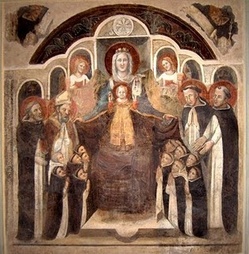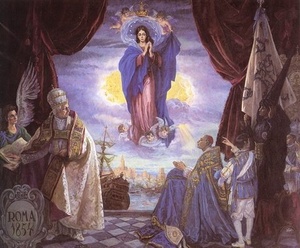Mary, the Mother of God, introduced herself as “I am the Blessed Virgin of the Poor” to an 11 year old girl in 1933. I am not all that familiar with this devotion to Our Lady of Banneux, but it is very appealing to me because of the gentleness of the vision and connection with the poor and the sick.
Category: Blessed Virgin Mary
Solemnity of Mary, Mother of God
God our Father, may we always profit by the prayers of the
Virgin Mother Mary, for You bring us life and salvation through Jesus Christ
her Son who lives and regins with You and the Holy Spirit, one God, for ever
and ever.
from Catechism of the Catholic:
Called in the Gospels “the Mother of
Jesus,” Mary is acclaimed by Elizabeth, at the prompting of the Spirit and
even before the birth of her son, as “the mother of my Lord.” In
fact, the One whom she conceived as man by the Holy Spirit, who truly became
her Son according to the flesh, was none other than the Father’s eternal Son,
the second person of the Holy Trinity. Hence the Church confesses that Mary is
truly “Mother of God.” (495).
from the Directory on Popular and the
Liturgy: The Solemnity of the Holy Mother of God:
On New Year’s Day, the octave
day of Christmas, the Church celebrates the Solemnity of the Holy Mother of
God. The divine and virginal motherhood of the Blessed Virgin Mary is a
singular salvific event: for Our Lady it was the foretaste and cause of her
extraordinary glory; for us it is a source of grace and salvation because
“through her we have received the Author of life.”
The solemnity of the 1
January, an eminently Marian feast, presents an excellent opportunity for
liturgical piety to encounter popular piety: the first celebrates this event in
a manner proper to it; the second, when duly catechised, lends joy and
happiness to the various expressions of praise offered to Our Lady on the birth
of her divine Son, to deepen our understanding of many prayers, beginning with
that which says: “Holy Mary, Mother of God, pray for us, sinners”.
In
the West, 1 January is an inaugural day marking the beginning of the civil
year. The faithful are also involved in the celebrations for the beginning of
the new year and exchange “new year” greetings. However, they should
try to lend a Christian understanding to this custom making of these greetings
an expression of popular piety. The faithful, naturally, realize that the
“new year” is placed under the patronage of the Lord, and in
exchanging new year greetings they implicitly and explicitly place the New Year
under the Lord’s dominion, since to him belongs all time (cf. Ap 1, 8; 22,13)
A
connection between this consciousness and the popular custom of singing the Veni
Creator Spiritus can easily be made so that on 1 January the faithful can pray
that the Spirit may direct their thoughts and actions, and those of the
community during the course of the year.+New year greetings also include an
expression of hope for a peaceful New Year. This has profound biblical,
Christological and incarnational origins. The “quality of peace” has
always been invoked throughout history by all men, and especially during violent
and destructive times of war.
The Holy See shares the profound aspirations of
man for peace. Since 1967, 1 January has been designated “world day for
peace”. Popular piety has not been oblivious to this initiative of the
Holy See. In the light of the new born Prince of Peace, it reserves this day
for intense prayer for peace, education towards peace and those value
inextricably linked with it, such as liberty, fraternal solidarity, the dignity
of the human person, respect for nature, the right to work, the sacredness of
human life, and the denunciation of injustices which trouble the conscience of
man and threaten peace. (115-117)
Feast of the Patronage of Our Lady of the Order of Friars Preachers
O God, who for the salvation of souls didst place the Order
of Preachers under the special protection of the most Blessed Virgin Mary, and
wast please to pour out upon it her constant benefits: grant unto thy
suppliants that we may be led unto the joy of heaven through the aid of that
same protectress whose memory we revere today. Through Christ our Lord. Amen.
Pray for the Friars Preachers on the anniversary of papal approval in 1216.
2 beating hearts, hidden but present in Mystery
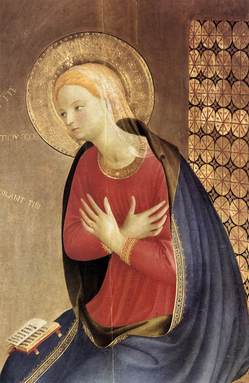 We have all had the occasion by a moment to sense more
We have all had the occasion by a moment to sense more
intensely the presence of Christ in the Eucharist during the celebration of the
Mass, during Eucharistic adoration, or even in the Tabernacle, when we walk
into a church. There is Christ. He is there whether we sense or experience His
presence. But precisely because this is the case, we are sometimes given
to experience that He is present. Such experience is not the source of faith,
but in some way it is its consequence.
Blessed Virgin Mary during Advent? It is reasonable, like the Fathers of the
Church, to see Mary as the original tabernacle. The Word became flesh and
dwells among us. This being hidden but present among us is first of all
realized during the time of Advent in the home of Nazareth, in the womb of
Mary, under the protection of Saint Joseph. Mary meditated upon all these
things and kept them in her heart. We can reasonably speculate that she read
scripture during this time, in silence, most likely the words of Isaiah, his
prophesies, and found in them a sense of the meaning of what was happening to
her.
conceived the Word in her flesh. So that her maternity was accompanied by an
intensification and growth in faith, in contemplation, in the intelligent
perception of mystery. The Second Vatican Council says that during the time of
her pregnancy the heart of the Incarnate Word beat gently below the heart of
Mary, her immaculate heart. Two immaculate hearts, beating silently and
prayerfully in the night of this world.
Our Lady of Guadalupe
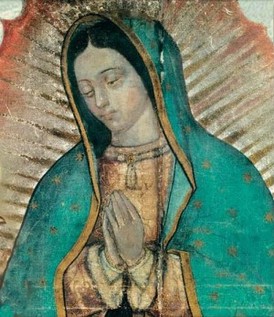 Our Lady of Guadalupe, Mystical Rose, make intercession
Our Lady of Guadalupe, Mystical Rose, make intercession
for the holy Church, protect the Sovereign Pontiff, help all those who invoke thee in their necessities, and
since thou art the ever Virgin Mary and Mother of the true God, obtain for us from thy most holy Son the
grace of keeping our faith, sweet hope in the midst of the bitterness of life, burning
charity and the precious gift of
final perseverance. Amen.
indulgence by Pope Pius X at all audience held on August, 1908, and was
included in the official edition of approved indulgenced prayers (1950).
Grace at work in Mary Immaculate
The privilege of Mary Immaculate does not consist solely in the absence of original sin, but much more in being “full of grace.” The Mother of Jesus gave to the world that very life which renews all things … and was enriched by God with gifts befitting such a role … She was adorned from the first instant of her conception with the splendors of an entirely unique holiness (Lumen Gentium 56).
Gabriel’s greeting, “Hail, full of grace, the Lord is with you!” is the strongest testimony of the Immaculate Conception of Mary, who would not be “full of grace” in the complete sense of the word if she had been stained by sin for a single moment.
Thus the Blessed Virgin began life with a richness of grace which far surpasses that which the greatest saints acquire at the end of their lives. When we also consider her absolute fidelity and her total availability to God, we can faintly imagine to what heights of love and communion with God she attained far beyond all other creatures in heaven and on earth (Lumen Gentium 53).
Fr. Gabriel of St. Mary Magdalen, O.C.D.
Divine Intimacy
Immaculate Conception of Mary
Vatican to comment on Medjugorje claims
The cardinal of Sarajevo, Vinko Puljic, said that the Holy See will make an official statement about the supposed apparitions of the Blessed Virgin Mary in Medjugorje. These sightings of Mary have been happening since 1981 to six people. The news story is seen here. This is a welcomed and necessary pastoral development.
Mary sustains our hearts
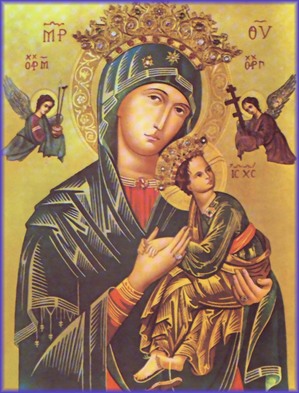 In danger, in distress, in uncertainty, think of Mary, call upon Mary. She never leaves your lips, she never departs from your heart; and so that you may obtain the help of her prayers, never forget the example of her life. If you follow her, you cannot falter; if you pray to her, you cannot despair; if you think of her, you cannot err. If she sustains you, you will not stumble; if she protects you, you have nothing to fear; if she guides you, you will flag; if she is favorable to you, you will attain your goal….
In danger, in distress, in uncertainty, think of Mary, call upon Mary. She never leaves your lips, she never departs from your heart; and so that you may obtain the help of her prayers, never forget the example of her life. If you follow her, you cannot falter; if you pray to her, you cannot despair; if you think of her, you cannot err. If she sustains you, you will not stumble; if she protects you, you have nothing to fear; if she guides you, you will flag; if she is favorable to you, you will attain your goal….
(Saint Bernard of Clairvaux, Hom. II super Missus est, 17: PL 183, 70-71.)
Medjugorje still garners attention
Until recently I really didn’t pay too much attention to
“new apparitions” of the Blessed Mother. I had all I can do to maintain what
knew or to explore what I wanted what I felt I needed to know about some of the
trends in Marian devotion. One more apparition of the BVM, even if current and seemingly
well-practiced, is not always interesting to me because of a perception that
yet another devotion to the Virgin Mary is creeping its way onto my plate
without ecclesial approval. Skepticism may be from the devil. I have raised the question about the truthfulness of this appearance of the BVM. But as Providence
would have, the apparitions of Mary from Medjugorje have found me. A few people
have written to me in the past suggesting that I have misread the situation
(perhaps I have) in a place like Medjugorje. Now I have a friend, a Franciscan
sister, keeping me informed on Marian visits. It’s all helpful, indeed and I
appreciate the feedback.
Reading the Catholic news services this morning I
noticed an article saying that the Bosnian cardinal, Vinko Puljic, thinks
someone at the Holy See (the pope?) is going issue a directive on Medjugorje’s claim
on the BVM making frequent visits there since the early 1980s. It is only speculation
at this point that the Holy See will say anything soon, but I do think he’s right in asking for such a directive to
appear for pastoral reasons. A little more guidance from the Holy See would be
extremely helpful. An evaluation of what has happened and what is happening
could set the record straight and help direct a reasonable pastoral response.
Throwing clichés and acidic words around on matters of doctrine, people
involved and spiritual practice is tantamount to spiritual malpractice. Plus,
fidelity to the teaching office of the Catholic Church is essential for true
Catholics. I just hope the Holy See takes Cardinal Puljic’s suggestion.
